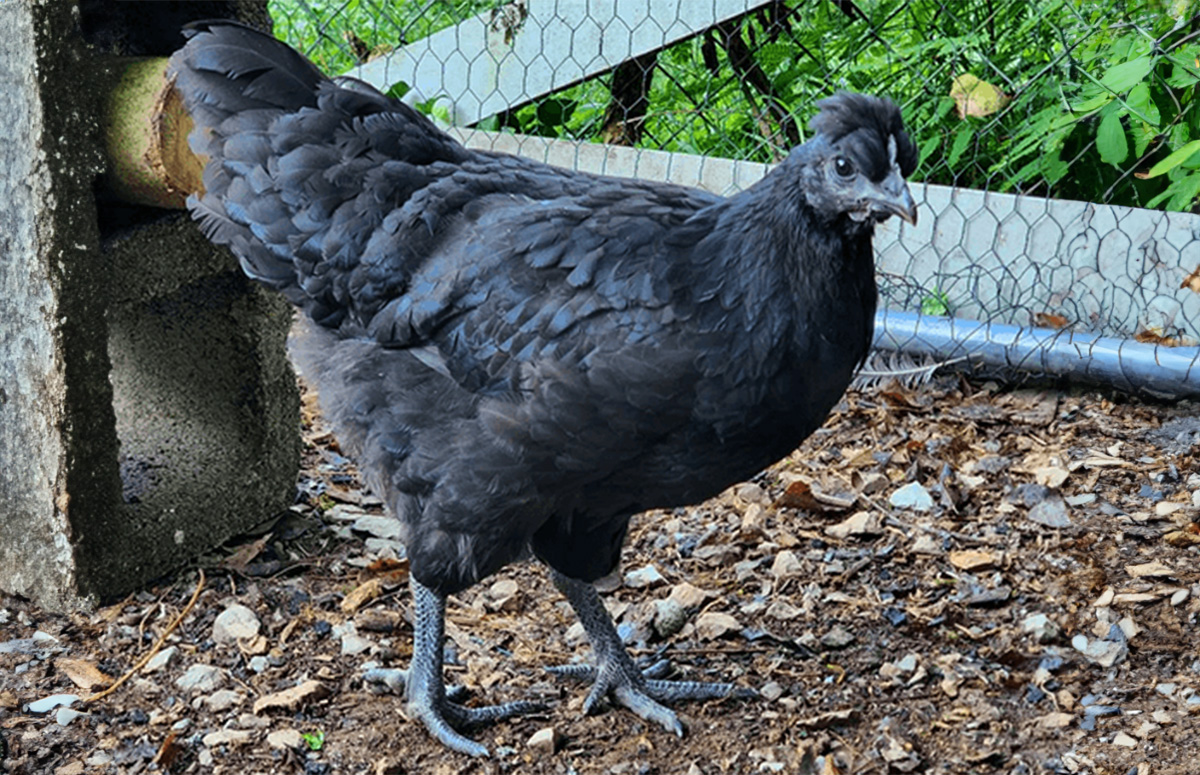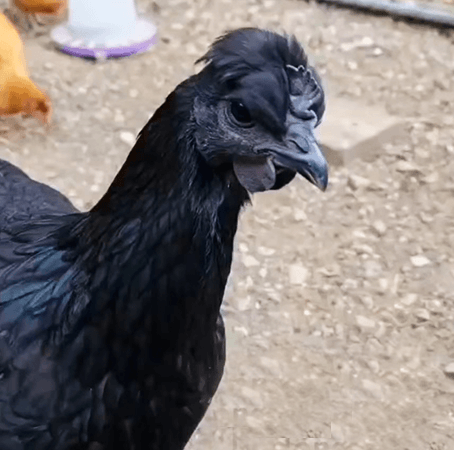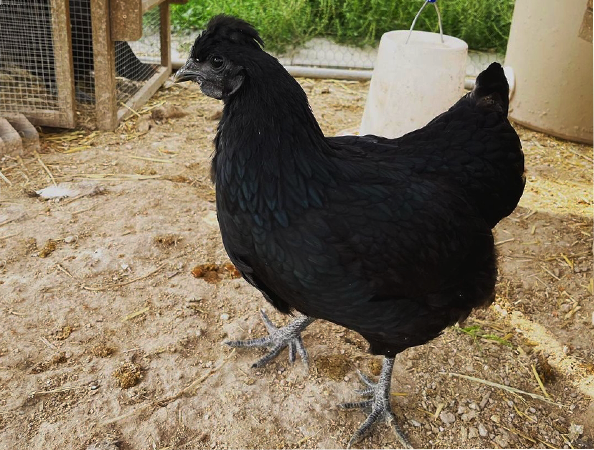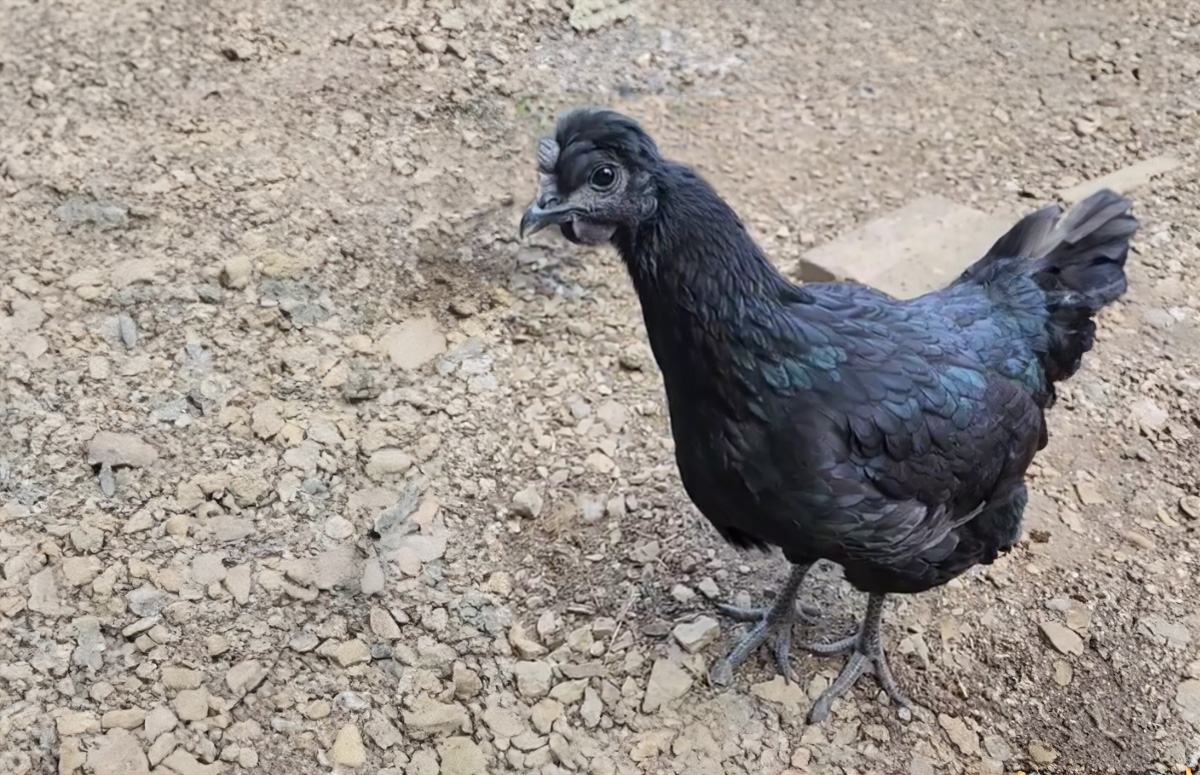Mystic Onyx Chicken: Complete Guide

If you’ve never heard of the Mystic Onyx chicken, don’t worry. It’s a relatively new breed, looking like an Ayam Cemani, but they’re pretty different. We’ll guide you through everything there is to know about this black beauty!
Let’s start by addressing some important topics:
- Mystic Onyx hens lay 220 light brown eggs yearly
- Cross breed of Silkies with meat birds
- Seldom broody
- Friendly chickens but active and energetic
- 220 Light Brown Eggs
- Special Black Looks
- Friendly Breed
- Not Always Entirely Black
- Energetic and Active
- Need More Space
Characteristics
This fairly recent breed has a remarkable appearance. It’s a black breed, meaning its feathering and skin are dark. However, they’re not as black as the Ayam Cemani or Svart Hona, worldwide known for their dark look.
| Eggs | 220 eggs per year |
| Egg Color | Light brown |
| Egg Size | Medium |
| Weight | 5 – 6 lbs |
| Hardiness | Cold and heat |
| Temperament | Friendly, energetic |
| Beginner-friendly | Yes |
| Color | Black with little orange flares |
Mystic Onyx chickens are not a real breed, they’re a hatchery mix of Silkies and a larger meat bird to create an attractive dual-purpose bird with dark skin, feet, and meat. But the plumage can look a bit diverse on different birds, although they’re mostly dark in color.
That’s why we added this breed to our ‘Beautiful Black Chicken Breeds‘ list.
Compare it to an Easter Egger; two Easter Eggers can look quite different but still are both labeled as an ‘Easter Egger’. So, since Mystic Onyx’s are a mixed breed, it’s not sure whether all chickens you’ll hatch or buy are entirely black or will look alike.
This is important to remember if you’re looking for a particular breed with specific color characteristics, as not all Mystic Onyx chickens will look the same.

A Mystic Onyx’s plumage is dark, mostly black, with orange to red flares. The black feathers have a greenish gleam. Roosters aren’t entirely black and have orange hackles. The breed has a single comb; some are crested. A Mystic Onyx chicken’s legs are clean, but since they originate from Silkies, they have five toes instead of four.
If your chicken does not have five toes, it’s probably not a Mystic Onyx, but another black cross-breed such as a Midnight Marans or Rustic Rambler.
Mystic Onyx Breed
As mentioned before, the Mystic Onyx is not a recognized breed but a hatchery mix, by cross-breeding Silkies with meat birds and selecting for dark skin and meat. The chickens are bred and distributed by Hoover’s Hatchery.
Many birds of the Mystic Onyx breed have a crested comb (not all) which makes chicken keepers believe an Americana (a type of Easter Egger), Ameraucana or Araucana is involved in the breeding process. However, the hatchery does not confirm this and can also be brought back to its Silkies background.
The American Poultry Association does not recognize the Mystic Onyx, so you can not enter this breed in poultry shows.
The name ‘Mystic Onyx’ is a trademark filed by Hoover’s Hatchery, registered in September 2021.

Onyx is a variety of chalcedony, a silicate mineral that tends to be black in its most common form. Add the adjective ‘mystic’ to it, and you have a commercial and catchy name for this exciting breed.
If you’re interested in black hatchery mixes, check out the Fibro Easter Egger, a completely black chicken, including bones and organs, that lays beautiful colored eggs.
Egg Production
The Mystic Onyx chicken was created as a dual-purpose breed, meaning it can be kept for meat production and egg-laying skills. They’re good layers and lay up to 220 light brown eggs annually. All eggs are medium-sized.
Mystic Onyx chickens do NOT lay black eggs. There is no chicken breed that lays black eggs, not even the Ayam Cemani, which lays cream-colored eggs.
Mystic Onyx hens reach sexual adulthood around 20 weeks old and start laying around the same time.
These birds are cold-hardy, which means they’ll keep on laying during winter, although egg production can slow down. They’re excellent laying hens giving you a year-round egg supply, except during molting.
One thing to remember is that Mystic Onyx hens seldom go broody. So, if you’re planning to hatch chicks, you’ll need an incubator or another breed to sit on the eggs. The main benefit is they won’t stop egg production frequently because of their broodiness.

Personality Of The Mystic Onyx
Although Mystic Onyx chickens are unknown to the large public (until now), they are a beginner-friendly breed. They are excellent egg layers and a great addition to your backyard flock or to keep as first chickens.
Due to their cold and heat tolerance, they are hardy birds that don’t need much extra care and can be kept in any climate. However, like any chicken, they need more supervision during extreme weather, especially during heat waves.
This breed is perfect for keeping when you have small children running around, as they are friendly and never aggressive. However, they are not lap chickens and aren’t very docile. They need plenty of space to stretch their legs and are excellent free rangers.
If you don’t have a large flock, meaning less than 8 chickens, and are looking for a decent-sized chicken coop that’s low in maintenance and parasite-free, take a look at our ‘Coops‘ page or check out whether the ‘Omlet Coop is Worth the Money?’.
Mystic Onyx chickens are not the best breed to keep in confinement. They are an active and energetic breed that needs daily exercise. If you don’t have the space to give the chickens a large pen or large chicken coop, or if you can’t let them free-range, there are better breeds available than the Mystix Onyx. After all, we all want our birds to be happy and comfortable.
If you want to protect your Mystic Onyx and other chickens from common nighttime predators, maybe installing an automatic chicken coop door is a solution. Many brands are available, including ChickenGuard, Omlet, Chickcozy and Run Chicken.
Summary
Don’t worry if you haven’t heard of the Mystic Onyx yet, as they are relatively new to the backyard chicken world. They were bred by Hoover’s Hatchery and registered in 2021. The Mystic Onyx is a cross-breed originating from Silkies and meat birds and selected for their dark meat and skin color.
They are a beginner-friendly breed with excellent egg-laying skills. But Mystic Onyx chickens are active and energetic birds that need plenty of space.
To learn more about chicken breeds, check out our ‘Chicken Breeds Page‘ to see every specific breed we address. Or go to our listicle breed summary on ‘The Classroom‘, or, if you’re unsure where to start, take a look at our ‘Chicken Breeds: Ultimate Beginners Guide‘.
Credits Featured Image: @865homestead (IG)
Related Questions
Mystic Onyx is a relatively new dual-purpose breed, registered by Hoover’s hatchery in 2021. They’re a mix of Silkies with meat birds and were selected for their dark meat and skin. This breed resembles the Ayam Cemani with its dark plumage but features red-orange flares in its feather colors.
Mystic Onyx hens lay light-brown, medium-sized eggs.
Mystic Onyx hens are good egg layers. They can lay up to 220 eggs per year, that’s more than four eggs per week.
No. There are no chickens that lay black eggs. Black chicken breeds like Ayam Cemani and Mystic Onyx lay cream-colored or light-brown eggs. Black chicken eggs on the web are chemically or artificially colored.
Yes. Mystic Onyx chickens are cold and heat-hardy. This means they can be kept in any climate and won’t stop laying during winter, although their egg production can slow down.






















